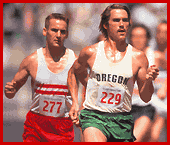Director of photography Conrad Hall, ASC discusses how his work in WITHOUT LIMITS helps define a complex character racing through life.
Writer/director Robert Towne’s new film, Without Limits, examines the life of legendary American track star Steve Prefontaine (played by Billy Crudup), a young man whose uncompromising determination to win his way sometimes cost him the race. Called "Pre" by both friends and admiring competitors, the athlete died at the age of 24 in a tragic 1975 auto accident, yet had already made his mark by appearing on the cover of Sports Illustrated in June of 1970 as a college freshman at the University of Oregon; breaking all seven U.S. running records between 2,000 and 10,000 meters; and competing in the 1972 Olympic Games (where he finished fourth, just missing a medal). Prefontaine was a crowd favorite who fiercely gave his all during every second of each meet. "Most people run a race to see who is fastest; I run a race to see who has the most guts," he once declared.
Without Limits was primarily photographed on location in Eugene, Oregon, specifically at the University of Oregon’s Hayward Field, where Prefontaine ran some of his most memorable races under the guidance of coach Bill Bowerman (Donald Sutherland). Competitive off the track as well, Prefontaine struggled against the rigid regulations of the Amateur Athletic Union, which he felt restricted runners from performing on their own terms.
Equally familiar with challenging convention is the picture’s director of photography, Conrad Hall, ASC, who previously worked with Towne on the 1988 neo-noir thriller Tequila Sunrise (see AC Jan. ’89). The collaboration, which Hall described at the time as "the best relationship I’ve ever had with a director," earned the esteemed cinematographer the ASC Outstanding Achievement Award, as well as an Academy Award nomination. Hall previously took home an Oscar for his work on Butch Cassidy and the Sundance Kid, and has been honored with five other Academy nominations, for the films Saboteur: Code Name Morituri, The Professionals, In Cold Blood, The Day of the Locust and Searching for Bobby Fischer. His other feature credits include Harper, Cool Hand Luke, Fat City, Marathon Man, Black Widow and the 1994 remake of Love Affair. He recently completed principal photography for the courtroom drama A Civil Action.
Our interviewer for this story, Caleb Deschanel, ASC, is an outstanding cinematographer in his own right and recently received ASC and Academy Award recognition for his work on Fly Away Home (see AC June ’97). Deschanel has also earned Oscar nominations for The Natural and The Right Stuff. His other feature credits include The Black Stallion, Being There and this summer’s romantic drama Hope Floats. He recently shot Message in a Bottle on location in Maine.
Hall and Deschanel’s conversation about Without Limits formerly titled Pre was conducted at the ASC Clubhouse in Hollywood. Among other things, they discussed the use of the Preston Cinema Systems’ Light Ranger, a unique auto-focus unit that allowed Hall to capture some of the film’s striking race action (see sidebar). Joining this portion of the discourse was the device’s inventor, Howard Preston.
David E. Williams
Caleb Deschanel: You’ve worked with Robert Towne before. How did your working relationship with him evolve on this new film?
Conrad Hall: Robert and I became friends during the making of Marathon Man [1976]. He’d been asked to do some additional writing on a scene unbeknownst to [screenwriter] William Goldman and we struck up a friendship. The best way to describe our working relationship is to say that Bob writes with words and I write with pictures, so the two of us make a complimentary storytelling team for film. He has his own ideas about visualization, but after rehearsing the actors, he lets me choose how to visualize his words. I’ll then set out a plan of attack for a scene and we’ll go through it together, adding and subtracting things until we have a final plan. That was the relationship we created on Tequila Sunrise, and it was wonderful. Bob doesn’t look though the camera very often, and on Tequila we didn’t even use video assist I was against it and he wasn’t for it.
Did he just sit back with his binoculars and watch the scenes?
Hall: [Laughs] Yes, that’s right! Bob’s usually there right by the camera, watching for what he wants to see from the actors. I assume that would usually be their faces. And oftentimes he doesn’t quite have in mind what’s going on with the camera, because when I occasionally do call him over to check a shot through the viewfinder to make sure we’re on the right track, he’ll sometimes be in awe of what he sees. Whatever he had imagined in his mind’s eye was often quite different from what we’d done because he’s not really trained to translate words into a visual form. But he’s usually quite happy and we have a great time working together.
That sounds like a great relationship. Directors aren’t always like that!
Hall: As we both know. Now, on Without Limits, Bob and I both wanted to continue with the working process we’d developed on Tequila Sunrise, but I had some problems with the script. I’d read an early version and I didn’t find myself emotionally involved with the story. I generally look for stories involving ethical and moral dilemmas traditional drama. But I didn’t see the drama in Steve Prefontaine’s story. There were a lot of track meets and some story points about the different philosophies Pre and his coach had about how to win a race, but that wasn’t enough for me and I turned down several versions of the script. After the last one, I recommended several other wonderful cinematographers for the job including yourself who evidently read the script and also turned it down.
[ continued on page 2 ]
